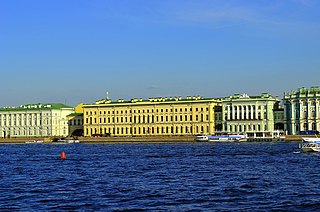
The State Hermitage Museum is a museum of art and culture in Saint Petersburg, Russia. It was founded in 1764 when Empress Catherine the Great acquired a collection of paintings from the Berlin merchant Johann Ernst Gotzkowsky. The museum celebrates the anniversary of its founding each year on 7 December, Saint Catherine's Day. It has been open to the public since 1852. The Art Newspaper ranked the museum 10th in their list of the most visited art museums, with 2,812,913 visitors in 2022.

Annibale Carracci was an Italian painter and instructor, active in Bologna and later in Rome. Along with his brother and cousin, Annibale was one of the progenitors, if not founders of a leading strand of the Baroque style, borrowing from styles from both north and south of their native city, and aspiring for a return to classical monumentality, but adding a more vital dynamism. Painters working under Annibale at the gallery of the Palazzo Farnese would be highly influential in Roman painting for decades.

The Pietà is a subject in Christian art depicting the Blessed Virgin Mary cradling the mortal body of Jesus Christ after his Descent from the Cross. It is most often found in sculpture. The Pietà is a specific form of the Lamentation of Christ in which Jesus is mourned by sole privilege of the Virgin Mary alone, whilst representing her "sixth sorrow" and sometimes accompanied by a specific Marian title.
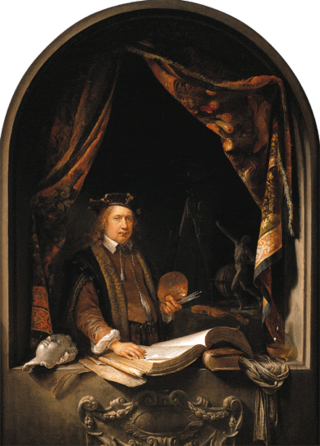
Gerrit Dou, also known as GerardDouw or Dow, was a Dutch Golden Age painter, whose small, highly polished paintings are typical of the Leiden fijnschilders. He specialised in genre scenes and is noted for his trompe-l'œil "niche" paintings and candlelit night-scenes with strong chiaroscuro. He was a student of Rembrandt.

The Russian Academy of Arts, informally known as the Saint Petersburg Academy of Arts, was an art academy in Saint Petersburg, founded in 1757 by the founder of the Imperial Moscow University Ivan Shuvalov under the name Academy of the Three Noblest Arts. Elizabeth of Russia renamed it the Imperial Academy of Arts and commissioned a new building, completed 25 years later in 1789 by the Neva River. The academy promoted the neoclassical style and technique, and sent its promising students to European capitals for further study. Training at the academy was virtually required for artists to make successful careers.

Picasso's African Period, which lasted from 1906 to 1909, was the period when Pablo Picasso painted in a style which was strongly influenced by African sculpture, particularly traditional African masks and art of ancient Egypt, in addition to non-African influences including Iberian sculpture, and the art of Paul Cézanne and El Greco. This proto-Cubist period following Picasso's Blue Period and Rose Period has also been called the Negro Period, or Black Period. Picasso collected and drew inspiration from African art during this period, but also for many years after it.
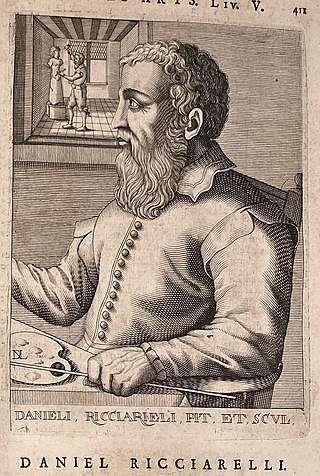
Daniele Ricciarelli, better known as Daniele da Volterra, was a Mannerist Italian painter and sculptor.
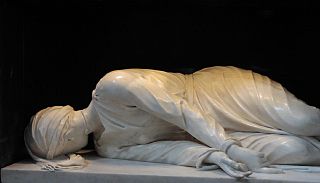
Stefano Maderno was one of the greatest Roman sculptors of the early 17th century.

Emilio Greco was an Italian sculptor, engraver, medallist, writer and poet. He is best known for his monumental bronze sculptures which are located around the world in museums such as - Tate Modern (London), Hermitage Museu Coleção Berardo (Lisbon), and Hawke's Bay Museum

Matthew Afanasyevich Chizhov (1838–1916) was a Russian sculptor.

Alexander Ivanovich Savinov was a Russian and Soviet painter and art educator who lived and worked in Saint Petersburg (Leningrad). He was a member of the Leningrad Union of Artists, regarded as one of the founders of the Leningrad School of painting.

Carlo Bartolomeo Rastrelli was an Italian sculptor and architect. Born in Italy, he moved in 1716 to Russia, where he worked until his death. His most famous works include the Monument to Peter I and a wax figure and several busts of Peter the Great. His son Francesco Bartolomeo Rastrelli became a prominent architect in Russia.
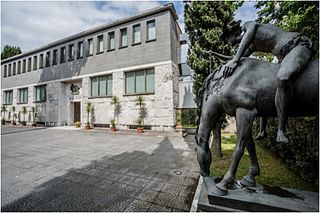
Museum Venanzo Crocetti is a contemporary art museum dedicated to the work of the Italian sculptor Venanzo Crocetti (1913–2003).

Dmitry Kawarga born in Moscow, Russia is a Russian artist. Kawarga began working in his own style of "biomorphism" striving to create a synthesis of science, art and technology. His art is featured in numerous museums and is part of the permanent collection of Erarta, Russia's largest private museum of contemporary art located in Saint Petersburg.

Descent from the Cross is an oil-on-canvas painting of 1600–1602 by the Flemish artist Peter Paul Rubens. It was his first major commissioned work made for the private chapel of Eleonora de’ Medici Gonzaga (1567–1611), duchess of Mantua. The painting remained somewhat obscure until 2001, when it was discovered by German art historian Justus Müller-Hofstede, a specialist on Rubens' early work.
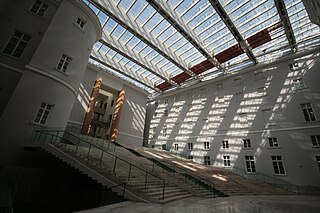
The State Hermitage Youth Education Center, is a contemporary art education program in Saint Petersburg, Russia that is part of The Hermitage Museum. The program is offered for all students, whether from St. Petersburg, other Russian cities or from abroad. Activities include lectures on the history and theory of art, exhibitions of contemporary art, masterclasses, and access to Museum curators and collections. There are also special semester programs for students studying from abroad. State Hermitage Youth Education Center organizes a number of international festivals and cultural programs on the history and traditions of different countries and nations.

Madonna and Child with Cherubs or The Virgin and the Child with Angels is an oil painting by the Italian Mannerist painter Rosso Fiorentino, produced sometime between 1512 and 1517. Originally on panel, it was later transferred to canvas. It was acquired in 1810 in Paris with help from the baron Dominique Vivant Denon for the Hermitage Museum in Saint Petersburg, where it now hangs.
The Muselli collection was one of the most notable art collections in 18th century Italy and - with the Gusti and Curtoni collections - a highlight of modern collecting in Verona.

Rocky Landscape with a Waterfall is an oil on panel painting by Flemish painter Joos de Momper. The painting was completed in the early 1610s, and currently housed at the Hermitage Museum in Saint Petersburg.

The Sagrestia Nuova, also known as the New Sacristy in English, is a mausoleum that stands as a testament to the grandeur and artistic vision of the Medici family. Constructed in 1520, the mausoleum was designed by the Italian artist Michelangelo. Situated adjacent to the Basilica di San Lorenzo in Florence, Italy, the Sagrestia Nuova forms an integral part of the museum complex known as the Medici Chapels.



















